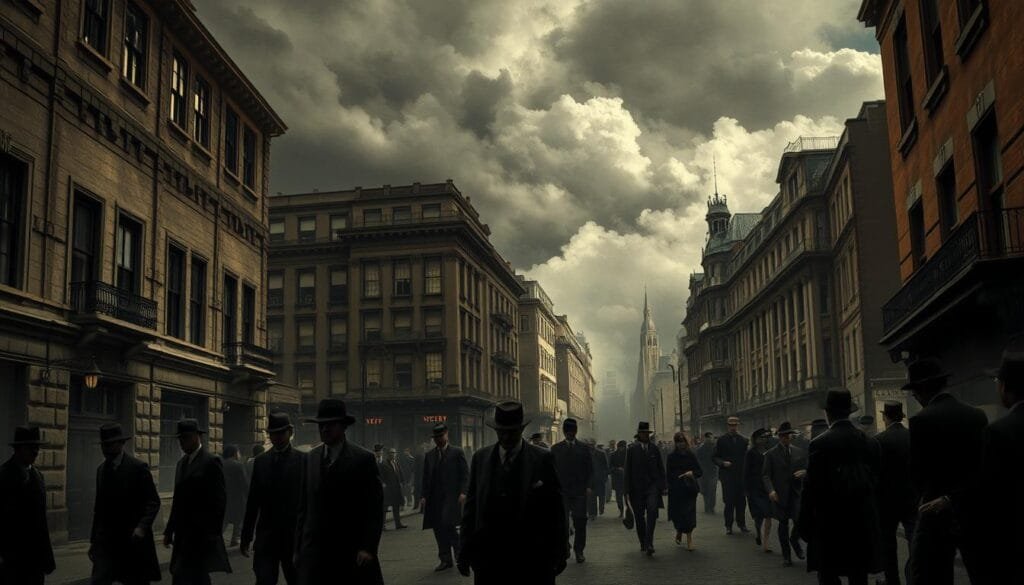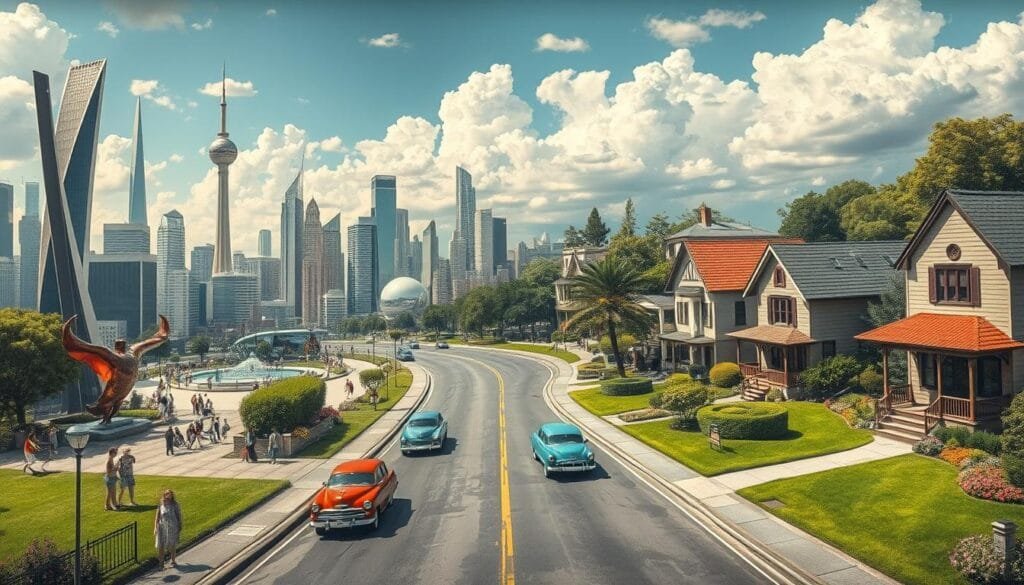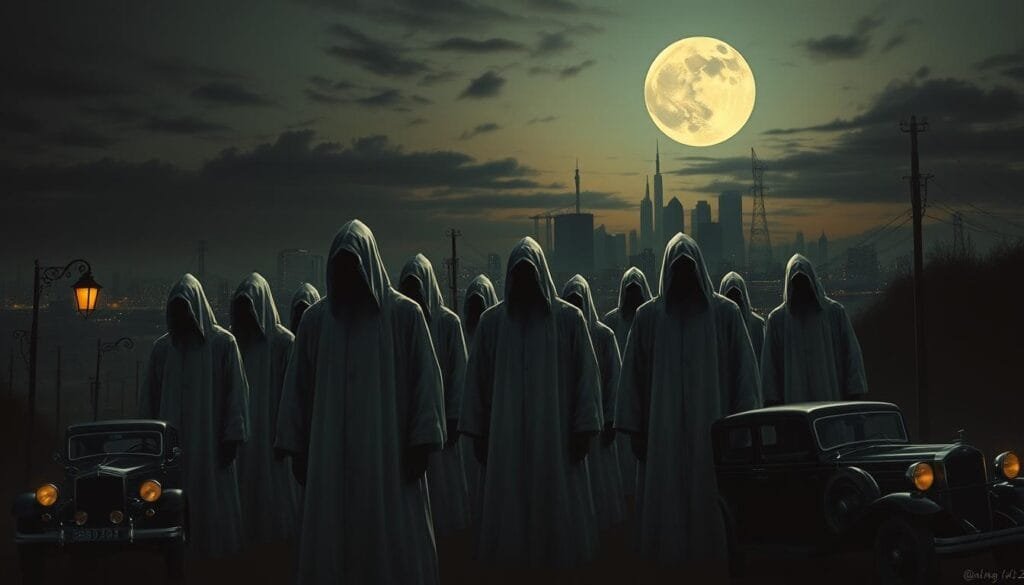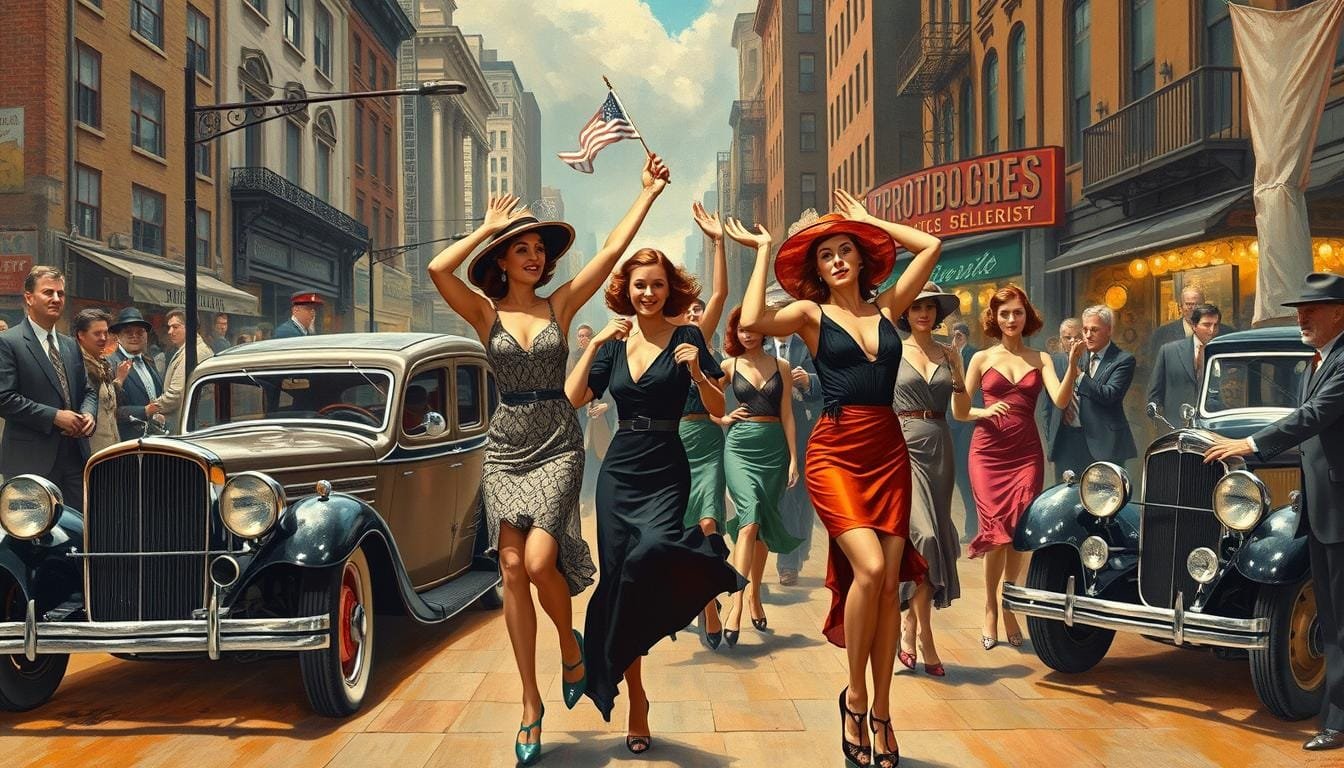Could one decade change a country’s culture so much it causes a divide for many years? The 1920s, known for its economic growth and cultural freedom, also saw much cultural tension. Through Frederick Lewis Allen’s “Only Yesterday,” we see the 1920s as a time of fun yet cynicism, caught between World War I and the Great Depression.
This period wasn’t just about prosperity and new ideas. It was more of a ‘cultural civil war’ as deep changes appeared. Cities versus rural areas, jazz against traditional values, marked this era. Debates over Prohibition, evolution, gender, and sexual morality showed America’s struggle with new freedoms and historical cultural conflicts after WWI.
Key Takeaways
- The temperance movement led to the passing of the 18th Amendment in 1919, sparking Prohibition.
- Over 400,000 speakeasies operated nationwide during Prohibition, showcasing widespread defiance.
- The Ku Klux Klan’s membership peaked during the 1920s, reaching around 4-5 million members by 1925.
- The Scopes Trial in 1925 spotlighted the tension between traditional values and modern scientific beliefs.
- Women’s participation in the labor force increased significantly, with around 8 million women holding jobs by 1920.
- The flapper culture emerged, representing a significant shift in gender roles among around 30% of urban women.
- The rise in the foreign-born population from 13% to 15% intensified debates over immigration.
The Post-War Climate and Its Role in Cultural Conflicts
After World War I, America entered a time of big changes and growth. This period brought both wealth and social shifts. But, it also had its troubles. Issues like labor unrest and fear of new ideas were common. These issues helped create big cultural conflicts in the 1920s.
Labor Unrest and Radical Ideologies
With the war over, America’s economy was booming. But, not everyone felt the benefits. Many workers started to demand better pay and conditions. From 1920 to 1929, strikes happened in many industries, driven by powerful ideas. Groups like the International Workers of the World led many of these strikes. They fought hard for the rights of workers.
Even though income was going up for many, it wasn’t equal. This unfairness led to lots of strikes in the 1920s. Workers were upset because they weren’t getting a fair share of the growing wealth.
Red Scare and Anti-Communist Sentiments
The time after WWI was full of fear of communism. This fear grew after the Bolshevik Revolution in Russia. Americans were very scared of any left-leaning ideas. They saw them as dangers. The case of Sacco and Vanzetti showed this well. They were tried and executed, mostly because of their beliefs. Their trial showed the strong anti-immigrant and anti-radical feelings of the time.

To sum up, America’s post-WWI period set the stage for the 1920s’ cultural battles. The mix of labor issues and fear of radical ideas created a tense environment. This backdrop was key in shaping the decade’s dramatic events.
Modernism vs. Traditionalism: The Heart of the Cultural Clash
The “Roaring Twenties” was a time of big changes in America. It showcased a battle between new and old values. The rise in buying things, thanks to a booming economy, made the U.S. focus more on consumers. Buying on credit became a new way of life.

New tech like cars and electric appliances became popular. By 1927, the U.S. was making 4 million cars a year. This highlighted the gap between new lifestyles and old values.
Consumerism and Mass Entertainment
The 1920s also changed how people spent their free time, with mass entertainment becoming big. Radios spread across the U.S., making jazz widely popular. By 1925, 10 million homes had radios. Jazz was key in nightlife, often in clubs that welcomed all races, despite segregation.
Movies also took center stage. The cinema drew crowds every week. Some films stirred controversy, reflecting the clash between new and old beliefs. They raised questions about race and society’s morals.
| Aspect | Modernism | Traditionalism |
|---|---|---|
| Radio Ownership | 10 million households by 1925 | Limited to urban areas, resisted in rural zones |
| Jazz Clubs and Speakeasies | Central to modern nightlife | Seen as immoral and contrary to traditional values |
| Movie Attendance | Millions of weekly viewers | Often censured or avoided by traditionalists |
| Prohibition | Led to the rise of illegal speakeasies | Supported as a moral imperative |
| Urban vs Rural Living | By the end of the 1920s, 45% living in cities | Rural population remained at 70% initially but shifted by decade’s end |
The battle over culture in the 1920s changed America. Mass entertainment didn’t just change how people had fun. It was also where new contested old values. This made American society complex, always finding its way in a fast-changing world.
A Characteristic of the 1920s Cultural Clash in America: Prohibition and Speakeasies
In 1919, the 18th Amendment led to Prohibition starting in 1920, a big change for America. Groups against saloons and those pushing for temperance wanted to clean up society’s issues with a moral campaign. Yet, this led to a boom in illegal speakeasies and a lively opposite culture.
Prohibition as a Moral Crusade
Prohibition was seen as a moral crusade aimed to stop social problems by banning alcohol. The Volstead Act set the alcohol limit at 0.5%, leading to strict enforcement. This resulted in over 500,000 arrests tied to Prohibition.
Initially, alcohol use dropped about 30%, showing some temporary success. But soon, challenges showed this win wasn’t going to last.
The Rise of Speakeasies and a Counter-Culture
Despite hopes, Prohibition led to speakeasies emerging everywhere. About 100,000 were thought to operate in the U.S. This hidden scene thrived as people found smart ways to get and enjoy drinks. Speakeasies were everywhere, and alcohol use started to climb again.
This created a strong American counter-culture. Figures like Al Capone made about $100 million a year from illegal booze. The black market for alcohol grew into a massive industry. It supported secret social events and big crime networks.
The effort to purify society actually made alcohol use a secret and filled criminals’ pockets. By 1932, half of American adults said they drank, even with Prohibition. As many people stopped caring about the old moral rules, the push against Prohibition grew. By 1933, 80% of Americans wanted it gone. This attempt at moral guidance had the opposite effect, leaving a major mark on culture and economy.
The Resurgence of the Ku Klux Klan
The Ku Klux Klan resurgence in the 1920s was fueled by racial, ethnic, and cultural issues. The film Birth of a Nation, out in 1915, played a key role in reviving the Klan’s image. It showed the KKK as heroes, stirring up the racial tension and fears among white Americans about societal changes.

The Influence of “Birth of a Nation”
D.W. Griffith’s film, Birth of a Nation, changed how people saw the Klan. It was one of the first big movies and it glorified the Klan’s actions against African Americans. This Birth of a Nation influence helped increase fears of racial mixing and made the Klan seem like America’s savior. As a result, Klan membership spiked to between 2.5 and 4 million people by the mid-1920s.
The Klan’s Nationwide Popularity
The Klan wasn’t just in the south; it had followers all over the country. There were huge numbers of members even in places like the northeast. For example, Vermont and Maine had 80,301 and 150,141 members, respectively. New Hampshire and Massachusetts also had significant Klan memberships.
The Ku Klux Klan got popular nationwide because of widespread racial and ethnic issues. There were nine million Catholic immigrants moving to the U.S. between 1890 and 1925. This made some people feel threatened and led them to support the Klan. The Klan fought against these new immigrants, wanting to keep America white and Protestant.
| State | KKK Membership |
|---|---|
| Maine | 150,141 |
| Massachusetts | 130,780 |
| Vermont | 80,301 |
| New Hampshire | 75,000 |
| Connecticut | 65,590 |
| Rhode Island | 21,321 |
The Klan also showed its power through public and political actions. On August 8, 1925, about 25,000 members marched in Washington, D.C. This was one of the biggest social movements in U.S. history. They also had a hand in electing 75 House members and several state governors.
So, to understand the Ku Klux Klan’s rise in the 1920s, we must see the mix of racial tension, cultural fears, and media influence. The film Birth of a Nation played a big part in their resurgence.
Gender Norms and the Flapper Phenomenon
The 1920s was a time when female roles started to change a lot, with the “flapper” leading the way. This new type of woman didn’t follow the old rules of how to act or dress. People saw flappers as symbols of freedom in their choices and actions.
The flapper movement happened during important changes in society. When the 19th Amendment passed in 1920, around 26 million U.S. women got the vote. This big step forward was part of a larger change in women’s roles.
After World War I, more women worked outside the home and their jobs changed. They even earned higher wages than before, showing how gender roles were evolving.
Flappers also changed fashion and culture. They wore shorter skirts and showed a new freedom in how they dressed. Movies like “Flaming Youth” in 1923 and Clara Bow’s “It” in 1927 showed everyone what flappers were about.
Changing Sexual Mores and Gender Roles
Flappers had a big impact on American culture. Ads targeted at women became common, recognizing they had money to spend. Women were now buying beauty products and even cigarettes more freely.
Flappers sparked discussions about women’s rights, sexuality, and morals. The number of women in universities soared, indicating big changes in gender roles.
Not everyone liked these changes. Some laws tried to control what women could wear. But by the 1920s’ end, cheaper cars made by people like Henry Ford gave young women more freedom. This helped cities grow too.
Then, the Great Depression in 1929 suddenly ended the flapper lifestyle. Yet, the flapper era’s impact on gender roles and how women saw themselves was lasting. It was a key moment in the ongoing changes in how society views gender roles.
Religious Conflict: Fundamentalism vs. Modernism
In the 1920s, America faced severe religious battles. These were mainly between religious fundamentalism and modernist movements. Key to this conflict was the Scopes “Monkey” Trial of the 1920s. It represented the divide in America over evolution’s place in schools. One side held tight to Biblical truths, while the other pushed for scientific understanding and modernity.
The clash between fundamentalists and modernists began in the Presbyterian Church. It quickly spread to other Protestant denominations across the USA. By the 1930s, modernists, with their more liberal theological views, had taken over mainline Protestant schools and publishers. This change marked a wider shift in American culture, showing how modernist ideas were reshaping society.
This split in American Presbyterianism has deep roots. It dates back to divides in 1741 and between 1836 and 1838. A disagreement over slavery in 1857 caused more splits. These divisions matched larger societal issues that fueled the 1920s religious conflict. After the Civil War, differing Presbyterian groups, including one from the Confederate States of America, highlighted long-standing religious rifts.
Harry Rimmer became famous during this time. He was known for his public discussions on evolution and the Bible. By the mid-1930s, Rimmer had given over 4,000 talks in schools. He highlighted the cultural importance of the battle between fundamentalism and modernism. His influence showed the public’s deep interest in these conflicts.
This era in American culture also featured debates in big venues, like the Metropolitan Opera House. These discussions paralleled today’s cultural conflicts. They showed that the struggle between fundamentalist and modernist viewpoints was a central part of American life in the 1920s.
| Event | Date | Significance |
|---|---|---|
| Scopes “Monkey” Trial | 1925 | Pitted religious fundamentalists against modernists over teaching evolution. |
| Formation of United Synod | 1861 | Resulted from Old School Presbyterians splitting. |
| Modernist Control Over Seminaries | 1930s | Marked the dominance of theological liberalism in Protestant institutions. |
| Harry Rimmer’s National Debates | 1920s-1930s | Highlighted religious and scientific discourses in public schools. |
Racial and Ethnic Tensions During the 1920s
The 1920s faced tough racial and ethnic issues. They led to stricter immigration laws and grew nativism. Many wanted to keep American values, hitting immigrants from Southern and Eastern Europe hard. This showed the wide dislike for foreigners. The Tulsa Race Massacre was among many race riots. It showed deep anti-black feelings and unrest, underlining the country’s racial divides.
Immigration Restrictions and Nativism
In the 1920s, tough immigration laws started. They aimed to limit immigrants from areas seen as undesirable. The Immigration Act of 1924 hugely cut immigrant numbers, mainly targeting Southern and Eastern Europeans. This act reflected rising nativism, where Americans wanted to keep their cultural identity. By limiting immigration, the U.S. wanted to keep its traditions and protect the economy from foreign workers.
Race Riots and Anti-Black Sentiments
After World War I, racial conflicts grew, especially in job competition. The “Red Summer” of 1919 hit over 26 cities. It was the start of the 1920s’ severe racial violence. Lynchings spiked, showing more anti-black feelings. The Chicago Race Riots killed 38 and left over 1,000 Black families without homes.
The Tulsa Race Massacre and the Elaine, Arkansas, incident killed hundreds of African Americans. These events showed deep racial hatred.
The Ku Klux Klan (KKK) came back strong in the 1920s. Their numbers reached millions, pushed by a nativism that also disliked Jews and Catholics. The Klan influenced views on alcohol, feminism, and American values. Few federal actions were taken against the KKK, showing deep-rooted anti-black feelings.
The Harlem Renaissance brought a cultural shift. Artists like Langston Hughes and Josephine Baker became well-known. Yet, widespread racism continued. Many Black Americans got only low-paying jobs and lived in ghettos. This happened in the North after many whites moved out, a trend called “white flight”.
| Event | Impact | Statistics |
|---|---|---|
| 1920s Immigration Laws | Reduced immigrant influx | Targeted Southern and Eastern Europeans |
| Red Summer of 1919 | Heightened racial tensions | Affected 26 cities |
| Chicago Race Riots | Violence and displacement | 38 deaths, 1,000+ homeless |
| Ku Klux Klan Resurgence | Escalated racial violence | Membership soared into millions |
Conclusion
The 1920s in America were a time of big changes and conflicts. This decade was marked by social and cultural clashes that left a deep mark on history. Economic problems, political changes, and shifts in culture made the 1920s complex. The death of over 115,000 American soldiers in World War I and a flu epidemic made things worse. This set the scene for big upheaval.
The end of the war saw a lot of labor unrest. Nearly 4 million workers held over 3,000 strikes in 1919. This showed how unhappy the working class was. At the same time, taxes for the rich dropped significantly. This happened under President Coolidge, with rates falling from 66% to 20%. These events led to bigger gaps between rich and poor, sparking cultural fights. These included the rise of Prohibition and speakeasies, and sadly, violent racial conflicts like the Greenwood Massacre.
Changes in women’s roles and the emergence of flappers highlighted shifting social norms. Women won the right to vote in 1920 with the Nineteenth Amendment. The fight between old values and new ones captures the era’s tension. Religious debates and feelings against immigrants added to the complexity of the 1920s. This decade’s events remind us that it was a key period in shaping American history. These cultural clashes and changes are still relevant today, teaching us lessons from the past.
FAQ
What were the main cultural tensions in 1920s America?
In the 1920s, America was full of cultural struggles. This included the battle between new and old ways of life, the birth of a consumer society, and debates over Prohibition.
How did the post-WWI climate contribute to cultural conflicts in America?
After WWI, America faced lots of cultural fights. The end of the war led to workers’ strikes, new political ideas, and the Red Scare. This scare was a widespread fear of communism.
What role did consumerism and mass entertainment play in the cultural clash of the 1920s?
In the 1920s, consumerism and entertainment were huge. They pushed the fight between modern and traditional values. This also helped start the flapper trend and a big cultural fight.
What was the impact of Prohibition on American society during the 1920s?
Prohibition had a big effect on society. It aimed to improve morality but led to illegal bars and a culture that went against social norms.
Why did the Ku Klux Klan experience a resurgence in the 1920s?
The Ku Klux Klan came back in the 1920s, partly because of a film called “Birth of a Nation.” They grew by playing on racial and ethnic fears, becoming popular across the country.
How did gender norms change during the 1920s?
The 1920s changed gender norms a lot. The flapper became a symbol of new freedoms and roles for women. Women wanted more independence and to express themselves freely.
What was the nature of the religious conflict between fundamentalism and modernism in the 1920s?
Religious fights between fundamentalism and modernism marked the 1920s. These fights were part of larger issues about evolution, the Bible, and religion’s place in life.
What were the major racial and ethnic tensions in the 1920s?
The 1920s had big racial and ethnic problems. There were tough immigration laws, nativism, riots, and anti-black feelings. These showed deep fears and prejudices in society.
How did immigration laws contribute to nativism in the 1920s?
Immigration laws in the 1920s made nativism worse. They slowed down immigration and showed a want to keep American identity. This was based on xenophobia and racial biases.
What were the main causes of race riots in the 1920s?
Race riots in the 1920s came from economic competition, living apart, and strong anti-black feelings. These riots showed America’s deep racial splits.
